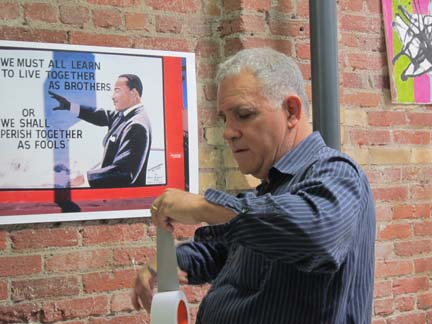At the end of the first week of August, Linda Fry and I drove up to downtown Los Angeles to help Lisa Thackaberry mount a show of Camilo Vergara’s photographs at the Lamp Community (527 Crocker Street). The Lamp is a service organization for the homeless, especially those who are teetering on becoming permanently embedded in bedlessness. In recent years, Vergara has been taking photographs of murals that include or feature Martin Luther King, Jr., almost all of which have been spontaneous creations done without official bureaucratic approval. As the fiftieth anniversary of King’s “I Have a Dream” speech approached, Vergara decided to organize simultaneous shows of his photographs of these murals at various places that would have been the major concern of King’s dream: those left on the margins whose sense of powerlessness has proven overwhelming. Linda and I had not know of The Lamp before making this trip, so we are grateful to Camilo and Lisa for offering this opportunity to become more aware of the specific quality (and quantity) of homelessness in Los Angeles.
I especially enjoyed the improvised quality of the show. The reproductions of the photographs were attached to one side of the brick hallway by maximum strength masking tape. The tricky part was trying to keep all the images aligned with each other as we spaced them out in a visually logical sequence. We also had to keep track of time, since street parking near The Lamp is set up so that a car cannot be parked for more than an hour. If it were only a question of feeding a meter, then that would have been no challenge, but there are no meters. The car itself must be moved to another side of the street or much further down the street to avoid a ticket. Thus, anyone who wanted to go to The Lamp to help as a volunteer would be facing the constant problem of interrupting one’s work in order to address the parking obstacle. Thus do the homeless further become isolated from those who might be concerned about their plight.
Vergara also had a show at the Rose Gallery at Bergamot Station in Santa Monica that opened just after his exhibition at The Lamp. This show, which ran from mid-August to mid-September, featured the nocturnal work of this master artist. This past spring Vergara was living in Los Angeles and waking up very early in the morning (as in 3:30 a.m.). He would drive out to sections of Los Angeles that are rarely photographed, even in the daytime, and catch the eerie glow of street lighting popping the blister of exterior wall lamps. There was a corner tire shop, for instance, in which the main object of business, elevated up near the painted store sign, seemed to glow in muted recrudescence with the nearby back of a stop sign, itself exuding an hexagonal sheen of turbid grey.
I was immediately reminded of W.C. Williams’s “Pastoral,” in which he speaks of the improvised housing of the “very poor,” in which the construction material for fences and outhouses has been assembled from discarded boxes and dismantled barrels. These objects, as Williams notes, are at least given the dignity of some minimal covering; they are “smeared a blusih green / that properly weathered / pleases me best of all colors.” It is this kind of coloration that Vergara has captured so well in these photographs. Williams mocks himself at end of his brief poem, “No one / will believe this / of vast import to the nation.” Vergara has no need for such ironic modesty. These photographs of Los Angeles at night should be widely exhibited throughout this city to remind us of the work that is done, by both artists and non-artists, to keep the flow of daily life in touch with more than superficial meaning.
In retrospect, the one thing I would now want to see would be photographs of the MLK murals at night. In particular, there is one of MLK on a brick wall which is cut off from a very close look by a padlocked chain fence. That it suggests the time that MLK spent in jail in order to move the freedom train along is part of its artistic rendering by Vergara. Nighttime in jail, though, is even harder time, and it’s the thought of that solitude, recreated by my imagined version of Vergara’s photograph, that I find even more haunting. Indeed, it is an image of import to the nation.
(contents of this blog, copyright Bill Mohr, 2013; photograph, copyright, Linda Fry, 2013)

 About Bill Mohr
About Bill Mohr